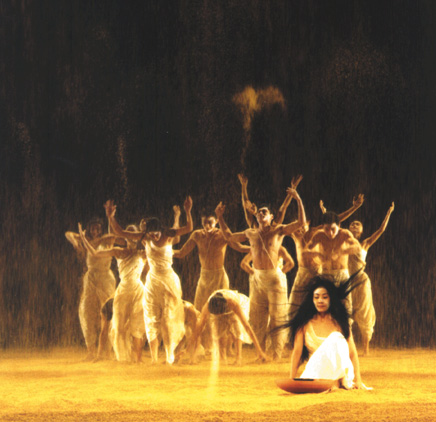 Dance Free
Dance Free


 Dance Free
Dance Free
Modern dancers strive for
utopia among constraints
by Becky Chu

D
ifferent from the rigid formality and artificiality of the classical dancing techniques, modern dance remains unique as a freedom of expression and natural body movement.
Said Mr. Cary Lee, a modern dance lecturer at the Hong Kong Academy for Performing Arts: “It is a combination of body and mind.”
The main theme in each performance is decided by a choreographer. Choreographers can express their own ideas and feelings through the body language of dancers. Thus, choreographers can be claimed as the spirit of dancing performances.
However, it is not easy to create an idea. One’s mind may be blank for several months.
Mr. Lee had been a choreographer before. He said, “It totally depends on one’s impulsive feeling.”
For him, ideas are usually inspired by immediate feeling towards a piece of music or anything around him. For example, one of his works describing the perplexity of city dwellers is originated from his feelings towards city life.
“As a choreographer is rather frustrating sometimes,” said Mr. Lee. This would happen when the outcome is far from expectation due to the incompatibility between the choreographer and dancers.
Sometimes, audience may find it difficult to get the message of modern dance. Whether the choreographers emphasizes self-expression or the communication between them and audience is in doubt.
Mr. Lee disagreed.“We all hope to be understood by audience. But it is not a serious problem if audience really don’t mind not understanding our dance.
“For me, I would like to make the message clear and obvious so as to avoid too much abstraction.”

Another indispensable element of a dancing group is dancers.
Financed by the Hong Kong Arts Development Council, City Contemporary Dance Company stages about seven large-scale dance performances in Hong Kong each year. Numerous small ones are also held in public estates, schools and shopping centres to arouse interest in modern dance.
The City Contemporary Dance Company is the only dancing company in Hong Kong that recruits full-time dancers for regular performances.
Dancers are recruited both locally and from overseas countries such as Taiwan and Malaysia. The comapny now has 11 full-time dancers.
Miss Abby Chan, 27, a local dancer, joined the City Contemporary Dance Company after graduating from the Hong Kong Academy for Performing Arts four years ago.
Miss Chan is also a choreographer of a small dancing group formed by her friends and her.
She regarded modern dance as part of her life.
She said, “Being a dancer, I get the largest satisfaction from the moment that I step on the stage and forget myself.”
But there is depressing moment when she cannot meet choreographers’ expectation.
Mr. Yap Poo-meng from Malaysia is another dancer of the City Contemporary Dance Company.
To him, modern dance provides him an alternative channel to express his own feelings and thinking through body movement.
Although Mr. Yap enjoys regarding modern dance as his career, he has encountered enormous pressure from his family.
When he decided to devote himself to dancing, his parents strongly opposed this because of the gloomy propects of dancers in Malaysia.
Mr. Yap said, “They feared that I could not earn my own living. But it’s better now. They know that it’s my own choice and I can support myself.”
Now his dream is to have a sum of money to stage his own production.
According to Mr. Kevin Wong, the publicity officer of the City Contemporary Dance Company, the current monthly wage of a full-time dancer in the company ranges from $15,000 to $20,000.
Both Miss Chan and Mr. Yap are optimistic towards their prospects.
Miss Chan would like to be a choreographer when she is too old to be a dancer, whereas Mr. Yap would choose to be a dancing teacher in a university.
The preparation of a large-scale performance usually takes several months.
To make a performance successful, apart from the choreographers and dancers, the help of light designer, set designer, music composer and costume designer also play an important role.
Mr. Wong also hopes the public would give up its prejudices about modern dance first.
Said Mr. Wong: “People are always reluctant to try new things and do not give themselves a chance to see what modern dance is.”

